 |
The Vanguard of the |
This is a NEGenWeb Project web page
and is presented as part of the
MARDOS Memorial Library Collection.
The Vanguard of the
Czech Pioneer
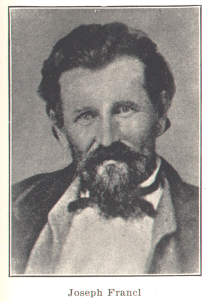
As far as is known, the first Czech to enter Nebraska was Joseph Francl, who travelled overland in 1854, on his way to the California gold fields. In that year the territory of Nebraska was organized and embraced what are now the states of Nebraska, North Dakota, South Dakota, Wyoming, Montana and Idaho. In that year too the city of Omaha was founded. Joseph Francl was born in Svojsice, County Caslav, Bohemia, in 1824. His father owned a brewery and glass factory. Francl studied music in the Prague Conservatory and later, in partnership with a Mr. Marschner, directed an orchestra and thus made many concert tours through Bohemia, Austria and Germany. About 1851 he came to this country and about 1852 he married in Wisconsin Miss Antonia Prochaska, who had emigrated there with her parents. Mrs. Francl was born February 17, 1834 in Kutna Hora, Bohemia, and died in Crete, Nebraska, November 21, 1911. Francl kept a diary during his trip and his son Fred, now living in Crete, permitted that same be used for the foundation of the account here given. Joseph Francl set out from Watertown, Wisconsin, April 18, 1854, with four companions, by ox teams, leaving behind his young wife and small son Fred, for he hoped to find riches for them in the gold fields. He travelled with Germans, three brothers, Gustavus, Adolphus and Friederickus Roseng von Stande, born on the island of Rugen in Germany, and Heinrich Merrman. Wisconsin and eastern Iowa were already somewhat settled, so they did not meet with any unusual experiences, aside from seeing large flocks of wild game and many elk and deer. They reached the Mississippi river on April 25th, at Dubuque, which city then had 10,000 inhabitants. Travelling on, they came to Iowa City, where they found a German brewery and refreshed themselves. The assembled company argued various questions pertaining to politics in Europe, for the Russian-Turkish war was raging. They found a Bohemian named Mudroch, from Malin, Bohemia, who had been for a time employed by a painter named Richter in Kutna Hora. And a Germanized Bohemian, a Dr. Adolph, who sold them salve to use against the cutting western winds. They proceeded along, passing the towns of Marengo and Newton. Their provisions consisted of 250 pounds hardtack, 150 pounds ham, 50 pounds butter, 50 pounds sugar, 30 pounds coffee, 10 quarts vinegar, 20 pounds beans, 10 pounds peas, spices, axes, chains, rope, augers, saws, 20 pounds gunpowder, 40 pounds lead and shot, -- and it was all too scanty for so long a trip. Francl mentions that they made and placed in the river a trap of willow twigs and thus caught several hundred pounds of fish in a short time. To prove this was not impossible, he relates that he had seen in the Rock River, twelve miles south of Watertown, when the water was low, so many fish of various kinds that one lay next the other as far as eye could see. Old inhabitants told him that eight or ten years before that, when they crossed the river in a wagon, the fish flew about on all sides, where the wheels struck them, like so many shavings. In Fort Des Moines (now Des Moines) they refreshed themselves in the tavern and set out again. The country was becoming more sparsely settled, the farms being twenty and thirty miles distant from each other. They saw a prairie fire and Francl has this to say about it: "I would like to describe the effect of a prairie fire at night, when it is cloudy or the night dark, but I cannot, words fail me to depict what I feel. It is a novel, magnificent, immense picture, which deserves the very ablest description, it I only could do it. A fiery band, reaching farther than the eye can see, a great quantity of smoke, and a terrifying glare, all the while silence reigns, for those who look on do not venture to speak. It is something incomparably beautiful." On June 3 they reached a hill in a small grove about three miles from Council Bluffs, Iowa, which town then, as he says, had 6,000 inhabitants and was a busy place, for emigrants outfitted themselves there. Apparently they did not stop there, but went seven miles south to the St. Mary settlement, across the river from Bellevue, where the ferry boat, owned by Peter A. Sarpy, plied back and forth. Sarpy was for more than thirty years Indian trader at Bellevue and Sarpy County is named for him. Francl says: 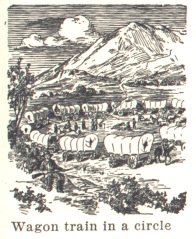
"Thank God we have made the 700 miles without misfortune. St. Mary consists of but a few houses. The state of Iowa is over 600 miles long, that is from Dubuque to Council Bluffs, 50,000 miles in area and contains 50,000 inhabitants. From Newton to the Missouri river we saw quantities of elk horns, some were 7 feet long and weighed about 30 pounds. We saw a drove of over 173 elk. They are about as large as a cow, of more slender body, of lighter color than deer, and keep only to the high prairies. We saw deer at streams. It may be understood that we did not suffer hunger, for we shot all the small game we could use. There is one kind of snipe, about as large as a medium-sized chicken, with bill about four inches long, that is easy to kill. They sell for three dollars in the large eastern markets. We roasted several and at last grew weary of them. The valley here is beautiful. How the water in the great river glistens and what a strange, crooked course the strong current makes for itself. How green are the grasses in this rich valley and what a fertile soil here awaits the hands of those who will cultivate it. Emigrants to California are preparing here for their journey and resting after their trip so far. Otherwise all is silence, only grazing horses and domestic animals are to be seen." Here Francl first saw western trappers, whom he describes thus: "These people are hired by fur traders for two years or for as long as their journey requires. They go in boats which the steamer pulls up the river against the current as far as it can, then they fasten their boats to the shore and proceed further in small boats to their destination, where they shoot, trap and trade with Indians. They exchange beads, calico, provisions etc. for tanned hides. Three large boats, filled with tanned and raw hides and pelts, await the steamboat here, to load it with their goods and return again for more. These trappers appear to me like lunatics. At least they could never walk the streets of a European town in their attire. From the remnants hanging in tatters on their bodies, it is difficult to say whether their clothing is cotton, linen or woolen. Wherever you look, you can see the owner's dark hide, the rest is covered with skins of wild animals. The trapper's face has not seen water during the many hundred miles of his travels. His hat is made of rough, raw buffalo skin, adorned by a fox or wolf tail. Some have attached in front the horns of deer or antelope. When the trapper's trousers give out, he takes a small buffalo hide, cuts it through the mouth, dries it by fire and smoke, and behold a pair of trousers, which he simply pulls on, the skins of the extremeties serving for suspenders. However, his boots make up for the rest, for they are quite handsome, embroidered by Indian women with beads and ornamented by a long fine leather fringe. They are very comfortable. These trappers are an uneducated, Godless sort of people, and most of them are Frenchmen from Canada. There is an abundance of game, but these trappers gamble away not only their money but even the last piece of decent clothing, if they happen to have it, and then go back to hunt again. 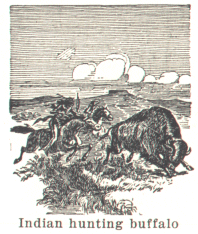
In the afternoon of the day of their arrival to St. Mary a wagon train consisting of 36 persons, 160 oxen and 30 horses arrived. It belonged to John F. Kinney, who was later a prominent Nebraska citizen. Mr. Kinney was born in New Haven, N.Y. He held public office in Iowa for some years and in 1853 was appointed justice of the supreme court of Utah. In the spring of 1854 he set out with his family on a trip 1500 miles long, for Salt Lake City, to take up his office. In 1856 he returned to Iowa, in 1857 he settled in Nebraska City and lived there with the exception of the year 1860, when again he was justice of the supreme court of Utah. He died in Nebraska City and it is interesting to note that he helped lay out the city of Beatrice, which was named for his eldest daughter. Inasmuch as both money and provisions were beginning to give out, Francl and his companions were glad to sell what they had left and their teams too to Mr. Kinney and enter his employ, Francl as cook, the rest as drivers. In the kitchen, one cook baked the bread, another carried water, another prepared the meats, another had the coffee, tea and dried fruits to look after and the fifth washed dishes. They were to get their pay after reaching Salt Lake City. The ferry carried across their train which now consisted of 28 wagons and 198 horses and oxen, and Francl stood on Nebraska territory soil. That evening a company of 27 Omaha Indians called and after their departure, Mr. Kinney missed a fine dog. The captain of the wagon train asked for volunteers to go to the Indian village, situated five miles west of Bellevue, in quest of the dog. Twenty-four men came forward and so the next day the party set out on horses and in wagons, well armed. Francl writes about that episode thus: "We came within ten feet of the village. About forty Indians advanced toward us, armed with bows and arrows, tomahawks, pikes, stone hammers and a few had old guns and swords, but they would not let us enter their village. Their chief crossed his arms on his breast and made us a speech, saying that the dog had been eaten, but that he would give us a horse instead. The Omaha Indians are of fine, tall bodies. They paint their faces red and yellow. They smear mud on their hair, to make it stiff and upright. From the nape of the neck to the forehead it stands out like a rooster's tail, the rest is clipped close. Their chief has a different style of head dress. Here the Indians begin to go about naked, except for a small apron. Some wear buffalo robes, with designs painted on them, sometimes embroidered with beads. Their moccasins are of elk or deer skin. Occasionally an Indian gets or trades for a pair of trousers, but he does not know that the seat is to be worn too. He cuts it out entirely and about all that is left are strings hanging from his sides. Each Indian carried a board about six inches wide and two feet long, pointed at the lower end. In the center is fastened a piece of glass from a mirror and the owner admires himself therein, adjusting his hair and complexion. "They would not let us enter their village all together, for they feared us. So we divided into three parts, laid aside our weapons and half the Indians accompanied us as guard. We did not see any women. Their village consists of twenty to thirty huts, made thus: Eight or ten long poles are arranged in a rounded pyramid, tied firmly at the top, and covered with tanned buffalo hides. The interior contains nothing but animal skins, which serve for a bed." Their quest was all in vain, for the chief made no mention of the horse and they returned empty-handed. That evening more red-skinned visitors appeared and the Indian agent requested them to sing and dance, which they did. One barked like a dog, another mewed like a cat, another howled like a wolf, another imitated a bear, etc. On June 14 they set forth across Nebraska. The distance between the wagons was thirty feet, the whole train was a mile in length. They stopped at the mission, where they found a well, and supplied themselves with water. They reached the Elkhorn river with no adventures to speak of and at this point the notes written by Francl have been lost. The continuation is taken up somewhere in what is now central Nebraska, for we read of the Lucky Ford and Wood rivers. Their way lay along the real western plains now, where Indians and wild animals threatened. Every evening all the wagons were drawn in a circle and the stock driven inside. This was commonly done, not only to keep the stock from wandering off, but as a protection against Indians. The third day after leaving Lucky Ford river they found a body partly devoured by wolves. It belonged to a man who had been driving 1500 sheep to California. The Pawnee Indians had taken 400 and then killed the owner. Mr. Kinney's people buried him. Some time at this stage of the journey, Mrs. Kinney gave birth to a boy, in Nebraska Center, on the Wood river. The buffalo range began here and they saw many come to Buffalo Creek, to drink. Francl thus describes a buffalo hunt: 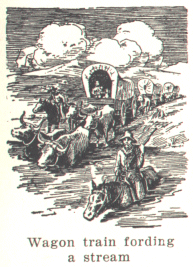
"We see our half-breed Indian, who is going along as hunter and interpreter, pursue the buffalo. When two yards away from him, he fires four times. Suddenly the animal turns on him and the Indian flees before him. The buffalo stops and the Indian approaches, turning him in our direction. The horse is weakening, for he has been hard at it for an hour and a half. A fresh horse is procured and the hunt goes on until the second horse is exhausted. The buffalo speeds toward the creek about half a mile distant. He hides in the high grass there, but others await him with revolvers. He stands motionless and allows them to shoot. Before a third horse can be brought, the buffalo is six miles away, hidden in the tall grasses on the shores of the creek. It was almost five o'clock before they got him out and stopped him with a rifle-shot in the leg, then they finished him. Both eyes were shot out and he bled from the mouth and sides. He weighed 2000 to 2300 pounds. We roasted and fried part of the meat and then smoked and dried the rest. The dried meat we hung under the wagon covers, to finish drying there. Each evening large droves of buffaloes came to drink, but we did not molest them. The following day, when we were travelling over a flat stretch of country, the captain ordered our train cut in half. There was quite a space between the two divisions. On the south of the road was a little valley where many buffaloes were grazing. Something frightened them, they ran through the division and we counted 2600. They are easy to count, for they follow closely in a line, in a sort of half-trot. The day following that we saw a magnificent sight. If anyone had told me before I had seen buffaloes that so many are in existence, I would not have believed it. On the other side of the river, to the left, was a great open space of prairie covered with buffaloes. As far as eye could reach, nothing but buffaloes. On the horizon great clouds of dust rose upward, where they were stamping around. These all belong to the Indian, they are his wealth. The calves are kept inside the drove, one can see how the old animals crowd together to protect them. This so-called buffalo range is about 130 miles in area." They saw and killed many rattlesnakes. They met a group of Sioux Indians returning from battle with Pawnees. One carried a sack from which blood was dripping. At length, after much sign language, they made him understand that they wanted to see what he had and he very willingly emptied it. It contained twenty-one scalps of the enemy. Each Indian, says Francl, knows well the scalp he has taken from the head of his victim, and he loves to turn it over in his hands and gloat over it. They reached Fort Laramie, built of sod and containing about twenty soldiers for the protection of emigrants. On September 2nd, 1854 they reached Salt Lake City, Utah. Mr. Kinney paid them their wages and Merrman and Francl, with six companions, on horses, set out for California, 800 miles distant, a good deal of the way over deserts. Water was found in each ten miles. They had not taken enough provisions and after a while suffered hunger. They found a poor old ox by the wayside, too weak to go any further and so they killed him. They had no salt, but even as they were famished, the meat was so tough they could not eat it. Francl remarks that he would give a year of his life for a loaf of bread. When their need was greatest, help arrived -- a wagon train. The owner gave them food and flour, which they cooked with water and called it soup. This train carried twelve people scalped by Indians. It consisted of 172 men, well armed, who had amused themselves all the way by shooting every Indian they met. No wonder the red men retaliated. From the passengers in this train Francl learned of the Mormon cow affair, which has gone down into Nebraska history as the fore-runner of Indian warfare. It happened thus: 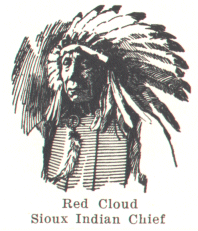
On the 17th of August, 1854, a party of Mormon emigrants on their way to the Great Salt Lake reached a great camp of thousands of Indians of the Brule, Oglala and Minneconjou bands, the whole Sioux nation on the plains, about eight miles east of Fort Laramie, Wyoming. They were gathered there to receive the goods which the United States had promised to pay them for the road through their land. Behind the Mormon wagons lagged a lame cow driven by a man. When near the Brule Sioux camp something scared her and she ran into the camp. A young Minneconjou, Shooters-In-The-Mist, killed her and his friends helped to eat her. The next day the Mormons complained to Lieutenant Grattan, commander of Fort Laramie, a young man only twenty-one years old, who had had no experience with Indians. On the morning of August 19th he set out with twenty-nine men and two cannon and conferred with the great chief The Bear, who said he would try to get the young Indian to give himself up. Grattan said if he would not he would fire and The Bear, pointing to the thousands of Indian men, women and children, said: "These are all my people. Young man, you must be crazy." A moment later two cannon and a volley of muskets were fired at the Sioux camp. The Bear was killed. A storm of Sioux bullets and arrows cut down Lieutenant Grattan and his men before they had time to reload their guns. The Sioux camp went wild and scattered over Nebraska, Wyoming and Dakota, urging Indians everywhere to kill the white men and drive them from the country. Thus the Sioux war began. The concensus of opinion has always been that Lieut. Grattan acted foolishly in this matter. Toward the end of their journey Francl and Merrman travelled alone and although they suffered more or less hardship for lack of provisions, they succeeded in crossing the Sierra mountains. They had no tent and slept on the ground in their blankets, sometimes finding themselves covered with snow. The notes end here and from several letters, dated in Placerville and Georgetown, California (the last in 1857), we find that luck was against them and they hardly made a living, to say nothing of finding gold. 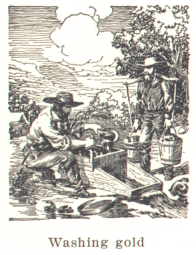
Francl returned to Watertown, where he taught piano and directed a singing society and for several terms was county clerk and clerk of the district court of Manitowoc County. In 1869 he left for St. Joseph, Mo. and went afoot to Nebraska City from there, making entry on a homestead in Saline County. In the fall of that year he settled thereon with his family, a mile south of Crete, near the old Indian ford. In August 1870 he built a store on the corner of 12th and Main streets in Crete and made a well. His corner was a stopping-place for emigrants, who replenished their supplies for the trip further. However, times were hard, the pioneers had no money, grasshoppers ruined crops and so in 1874 Francl again set out for California, to try his luck. He visited his old haunts, Georgetown and Placerville, but fate again was against him. In the meantime his son Fred had gone to Oregon, where with Theodore Daum he lived near Walla Walla, in the Blue Mountains, there occupied with making cord wood. On March 5, 1875 Francl set out afoot for Walla Walla, arriving in Portland, a distance of 600 miles, April 3rd. He found Fred in the mountains and in November of that year all three set out, on horseback, for California. A few days later Fred turned back, intending to take the boat. On December 3rd Francl and Daum camped near a large spring. Daum walked off a ways to look for the right direction and when he returned half an hour later, Francl had vanished. Daum spent the rest of that day and the next in a fruitless search. The following day he found his way to an Indian settlement, where he was directed to the Klamath Indian Agency and there he met people who accompanied him back to aid him in looking for Francl who was discovered dead, his horse tied to a tree nearby. He had ailed for eleven days, had eaten nothing and part of the time was delirious. That and the arduous journey through deep snow had hastened his end. In 1915 his sons Ernest and Joseph searched for his grave, for he had been buried in the cemetery at Fort Klamath, but in vain. His sons are: Fred (Crete, Neb.), George (Los Angeles, Cal.), Ernest (Crete), and Joseph (San Francisco, Cal.) and his daughters: Mrs. Clara Segelke (Beatrice, Neb.) and Mrs. Helen Jenista (Rock Island, Ill.), all living at date of writing. 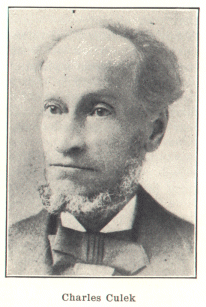
As far as is known, the next Czech to enter Nebraska, and the first to become a permanent settler, was Charles Culek. Later he spelled his name Zulek. It is probable that English-speaking friends called it Kulek, and as the letter C in Czech has the sound of ts, pronouncing it Zulek came a little nearer to the true sound. Culek was born in Podmoklany, County of Chotebor, Bohemia, June 23, 1822. He lived for a time in Germany, where he married a German maiden. Then he lived in Hungary, later in Bohemia and in 1854 he came to this country, to Freeport, Illinois. There he became acquainted with Germans, with whom in 1856 he set out for Nebraska and came to Arago, a little town in Richardson County, on the Missouri River, August 27, 1856. At that time there was a German settlement there. He took a claim four miles from the town of Humboldt. The nearest trading point was St. Joseph, Mo., where at first he used to walk for provisions. These he carried on his back and when his burden became too heavy, he would set down a portion, carry the rest, then walk back for the first part. Thus he continued along the distance of seventy-five miles each way. Travel between Arago and St. Joseph was by boat. Old settlers recount that as many as four boats were anchored at the landing at a time. There was an Indian reservation in Richardson County and the red men visited Culek's family, his children played with theirs. Culek was known among his countrymen far and wide. All of those who came after him to Richardson County turned to him for advice and help, and almost all at first worked for him. The first house he built, of stone, is still standing under a hill, near the Nemaha river. Culek or Zulek died in Humboldt on May 17, 1896. His son and daughter live in Los Angeles, Calif., the other daughter in Humboldt. As far as known, the next are L. A. Schlesinger and Joseph Horsky. 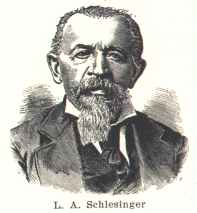
Libor Alois Schlesinger was born October 28, 1806 in Usti nad Orlici, Bohemia. He participated in the political revolution of 1848 and was arrested for inciting revolt. He was elected member of the City Council and was set free, but kept under surveillance. He came to Cedar Rapids, Iowa, in the latter part of 1856, thence via Sioux City to what is now Washington County, to the Omaha Indian reservation, sixty miles north of Omaha, where he took a homestead in the spring of 1857. On October 25, 1860 he went by team to Denver, reaching there December 3rd, and thereafter freighted between Omaha and Denver. In 1865 he settled on a homestead near Denver, in 1876 retired to that city, where he died February 26, 1893. His descendants live in Denver. 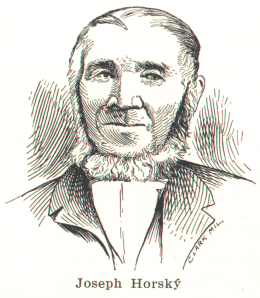
Joseph Horsky followed Schlesinger. He was born in Borovnice near Kostelec nad Orlici, Bohemia, in 1806, and came to Linn County, Iowa, in 1856. In 1859 Horsky and his sons travelled by covered wagon to Pike's Peak, where gold had been found, but returned three months later to Iowa. Soon thereafter he moved with his family to a claim he had taken in Washington County, Nebraska. In 1863 he moved to Helena, Montana, where he died in January 1900, and where his descendants live. After these four men, as far as is known, the next to come was Frank Walla. Sometime in the early sixties, as recorded in the history of Cuming County, Mr. Walla had left his home in Wisconsin on an exploring trip, during which he visited the Elkhorn Valley in Nebraska. Upon his return home he told relatives and friends about that valley and in 1864 the first Czech (being his sister Anna with her German husband Gottlieb Schlecht) arrived in Cuming County. About that time Vaclav Tucek settled in Omaha. In that same year John Herman and Robert J. Shary (Sary) settled in Arago. In that year perhaps, but certainly in 1865, Vaclav Petracek conducted a tavern in Nebraska City. Shary and Herman too had lived in Wisconsin and Shary had also taken an exploring trip, which resulted in their coming with their families to Nebraska. They established a distillery in Arago and conducted a sort of tavern, for in the following year quite a few transients stopped there, on their way to homesteads. These came via St. Joseph, up the Missouri river, before the Union Pacific Railroad was built. Instances have been recorded of Czech pioneers coming from Wisconsin all the way by ox-team, indeed some afoot, but most of them used either means from the nearest railroad station, in those days scarce and distant enough. When the railroad was built through Nebraska, the problems of transportation were solved to a great degree, for those who came by wagon or afoot had to meet not only the difficulty of transporting provisions, but furniture, implements, etc. also. Transportation facilities by railway smoothed out those difficulties and it is evident from the history of the counties that, beginning with 1867, they were settled more rapidly. |
| Back | Table of Contents | Next |